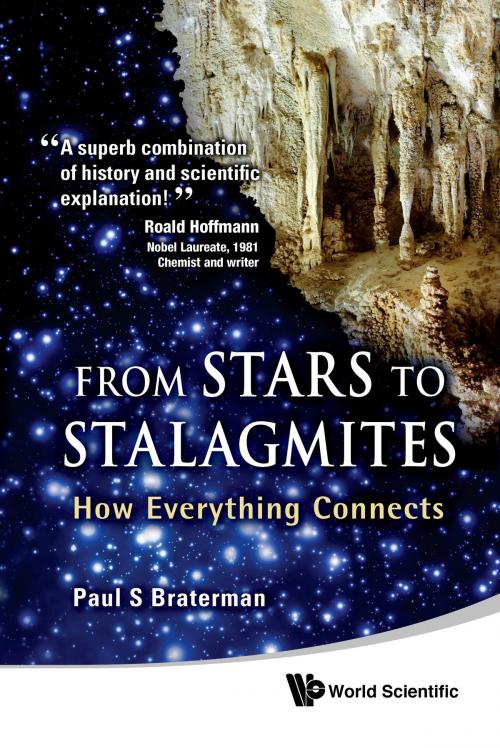From Stars to Stalagmites
How Everything Connects
Nonfiction, Science & Nature, Science, Other Sciences, History| Author: | Paul S Braterman | ISBN: | 9789814440691 |
| Publisher: | World Scientific Publishing Company | Publication: | April 16, 2012 |
| Imprint: | WSPC | Language: | English |
| Author: | Paul S Braterman |
| ISBN: | 9789814440691 |
| Publisher: | World Scientific Publishing Company |
| Publication: | April 16, 2012 |
| Imprint: | WSPC |
| Language: | English |
Feynman once selected, as the single most important statement in science, that everything is made of atoms. It follows that the properties of everything depend on how these atoms are joined together, giving rise to the vast field we know of today as chemistry. In this unique book specifically written to bridge the gap between chemistry and the layman, Braterman has put together a series of linked essays on chemistry related themes that are particularly engaging.
The book begins with the age of the earth, and concludes with the life cycle of stars. In between, there are atoms old and new, the ozone hole mystery and how it was solved, synthetic fertilisers and explosives, reading the climate record, the extraction of metals, the wetness of water, and how the greenhouse effect on climate really works. A chapter in praise of uncertainty leads on to the “fuzziness” and sharing of electrons, and from there to molecular shape, grass-green and blood-red, the wetness of water, and molecular recognition as the basis of life.
Organised in such a way as to illustrate and develop underlying principles and approaches, this book will appeal to anyone interested in chemistry, as well as its history and key personalities. Where many other titles have failed, this book succeeds brilliantly in capturing the spirit and essence of chemistry and delivering the science in easily digestible terms.
Contents:
- The Age of the Earth — An Age-Old Question
- Atoms Old and New
- The Banker Who Lost His Head
- From Particles to Molecules, with a Note on Homoeopathy
- The Discovery of the Noble Gases — What's so New About Neon?
- Science, War, and Morality; The Tragedy of Fritz Haber
- The Ozone Hole Story — A Mystery with Three Suspects
- Rain Gauge, Thermometer, Calendar, Warning
- Making Metal
- In Praise of Uncertainty
- Everything is Fuzzy
- Why Things Have Shapes
- Why Grass is Green, or Why Our Blood is Red
- Why Water is Weird
- The Sun, The Earth, The Greenhouse
- In the Beginning
Readership: Intellectually curious non-scientists, scientists who are interested in the wider context of chemistry, and (perhaps most important) teachers at all levels who wish to show their classes that chemistry is not a mass of dead data, but a vibrant cultural activity.
Key Features:
- This book is unique in its range of subject matter, its level of treatment, and the manner in which the material is related to its historical and intellectual context. The topics chosen are of fundamental importance, of topical interest, or illustrate particularly important interactions between scientific developments and society
- Each topic is presented within its historical context, and with descriptions of the key players and what was at stake for them
- Finally, the underlying science is discussed in non-technical language in a context that makes it meaningful, and this principle is applied to such “difficult” topics as thermodynamics and the nature of chemical bonding
Feynman once selected, as the single most important statement in science, that everything is made of atoms. It follows that the properties of everything depend on how these atoms are joined together, giving rise to the vast field we know of today as chemistry. In this unique book specifically written to bridge the gap between chemistry and the layman, Braterman has put together a series of linked essays on chemistry related themes that are particularly engaging.
The book begins with the age of the earth, and concludes with the life cycle of stars. In between, there are atoms old and new, the ozone hole mystery and how it was solved, synthetic fertilisers and explosives, reading the climate record, the extraction of metals, the wetness of water, and how the greenhouse effect on climate really works. A chapter in praise of uncertainty leads on to the “fuzziness” and sharing of electrons, and from there to molecular shape, grass-green and blood-red, the wetness of water, and molecular recognition as the basis of life.
Organised in such a way as to illustrate and develop underlying principles and approaches, this book will appeal to anyone interested in chemistry, as well as its history and key personalities. Where many other titles have failed, this book succeeds brilliantly in capturing the spirit and essence of chemistry and delivering the science in easily digestible terms.
Contents:
- The Age of the Earth — An Age-Old Question
- Atoms Old and New
- The Banker Who Lost His Head
- From Particles to Molecules, with a Note on Homoeopathy
- The Discovery of the Noble Gases — What's so New About Neon?
- Science, War, and Morality; The Tragedy of Fritz Haber
- The Ozone Hole Story — A Mystery with Three Suspects
- Rain Gauge, Thermometer, Calendar, Warning
- Making Metal
- In Praise of Uncertainty
- Everything is Fuzzy
- Why Things Have Shapes
- Why Grass is Green, or Why Our Blood is Red
- Why Water is Weird
- The Sun, The Earth, The Greenhouse
- In the Beginning
Readership: Intellectually curious non-scientists, scientists who are interested in the wider context of chemistry, and (perhaps most important) teachers at all levels who wish to show their classes that chemistry is not a mass of dead data, but a vibrant cultural activity.
Key Features:
- This book is unique in its range of subject matter, its level of treatment, and the manner in which the material is related to its historical and intellectual context. The topics chosen are of fundamental importance, of topical interest, or illustrate particularly important interactions between scientific developments and society
- Each topic is presented within its historical context, and with descriptions of the key players and what was at stake for them
- Finally, the underlying science is discussed in non-technical language in a context that makes it meaningful, and this principle is applied to such “difficult” topics as thermodynamics and the nature of chemical bonding















